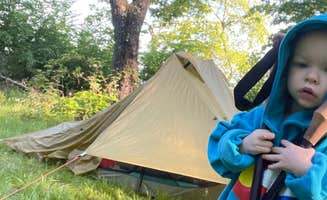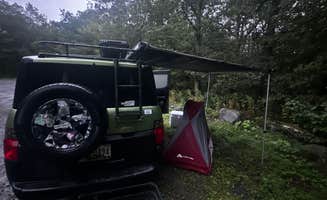Rustic camping near Nesquehoning, Pennsylvania offers primitive outdoor experiences in the eastern Pennsylvania highlands where elevations range from 800 to 1,600 feet. The region's mixed hardwood forests provide seasonal camping conditions with peak accessibility from April through October. Weather patterns in this section of the Appalachians can change rapidly, with temperature variations of 20-30 degrees between day and night.
What to do
Hiking network exploration: Thunder Swamp Trailhead provides access to an extensive trail system. "Trailhead parking was chill for a night. No trouble. Tons of hiking. Went down Saw Creek trail to a marsh," notes Jason R. from Thunder Swamp Trailhead.
Rock scrambling: Bake Oven Knob offers challenging terrain with geological features. "The hike to the overlook is really lovely; short and rocky," reports Dani T. from Bake Oven Knob.
Overnight parking: For those in small vans or vehicles, some trailheads permit overnight stays. Benjamin H. from Thunder Swamp Trailhead states, "It's a gravel parking lot. Plenty of shade. No one bothered me."
What campers like
Hammock-friendly terrain: The sloping topography works well for hammock setups at certain sites. Katharine T. from Appalachian Trail- Designated Backpacker Campsite 2 confirms, "Good trees for hammocking."
Communal yet private options: Sites often provide flexibility in camping arrangements. "We camped nearer to others but there are secluded spots too," notes Katharine T. about the Appalachian Trail campsite.
Bear safety provisions: Wildlife protection measures add peace of mind. Katharine T. mentions the site is "well maintained w bear boxes provided," reducing wildlife concerns for overnight stays.
What you should know
Water availability challenges: Planning for water is critical when primitive camping in this region. Renee Z. advises about Appalachian Trail- Designated Backpacker Campsite 2: "I gave the site only four stars because there's no water nearby... Stock up on water at the Dunnfield creek natural area, or wait until Sunfish pond."
Unmarked but findable sites: Some designated camping areas lack clear signage. "The site itself is unmarked when you come to it, but it's the only pretty obvious camping spot on the trail so it's not hard to find," explains Renee Z.
Parking lot camping options: Some trailheads serve as simple overnight options for vehicle-based camping. Dani T. reports: "I've overnighted in my van here a bunch, no problems" when describing Bake Oven Knob.
Tips for camping with families
Trail shelter limitations: Families expecting structured camping facilities should adjust expectations. Katharine T. notes, "We had thought there was a shelter (there isn't) but it was fine."
Slope considerations for tents: Terrain can challenge tent setup for larger family shelters. Renee Z. cautions the Appalachian Trail site is "a little on the small and sloped side for tent camping."
Strict regulation awareness: Children need clear boundaries about camping restrictions. Renee Z. mentions, "There are lots of signs around Sunfish pond itself that there's no camping allowed," highlighting the importance of following designated camping areas.
Tips from RVers
Trailhead overnight parking: Some parking areas permit overnight stays in small vans. Dani T. reports about Bake Oven Knob: "This spot is both part of the Appalachian Trail and a day hiking area for the Bake Oven Knob... There are two large lots. You can park and sleep, or hike in and find a place for a tent."
Limited services: No hookups or facilities exist at any of these primitive sites. RVers must be fully self-contained with water reserves, waste storage, and power.
Shade availability: Some parking areas provide natural shelter from summer heat. Benjamin H. notes about Thunder Swamp Trailhead, "Plenty of shade. No one bothered me."



